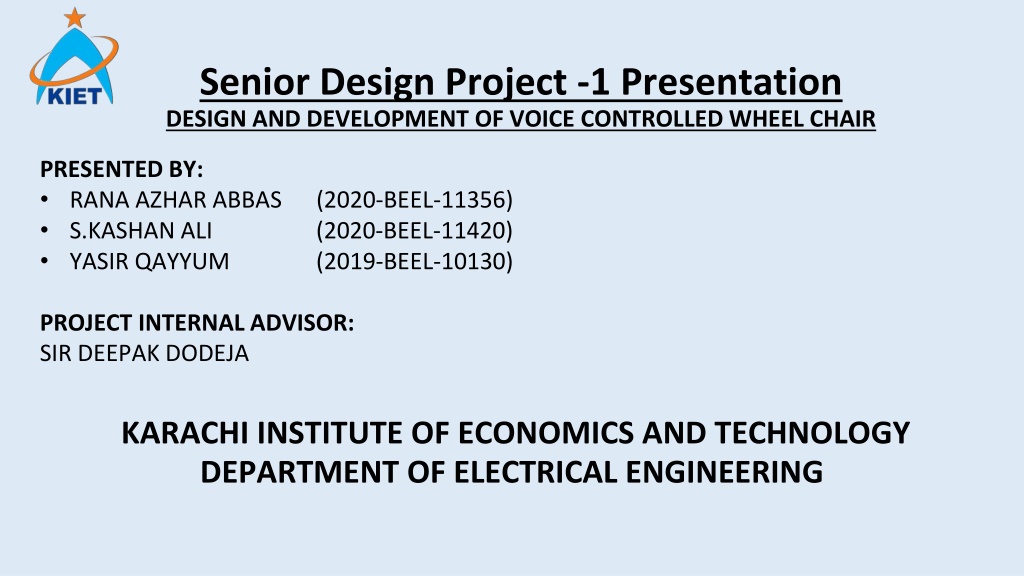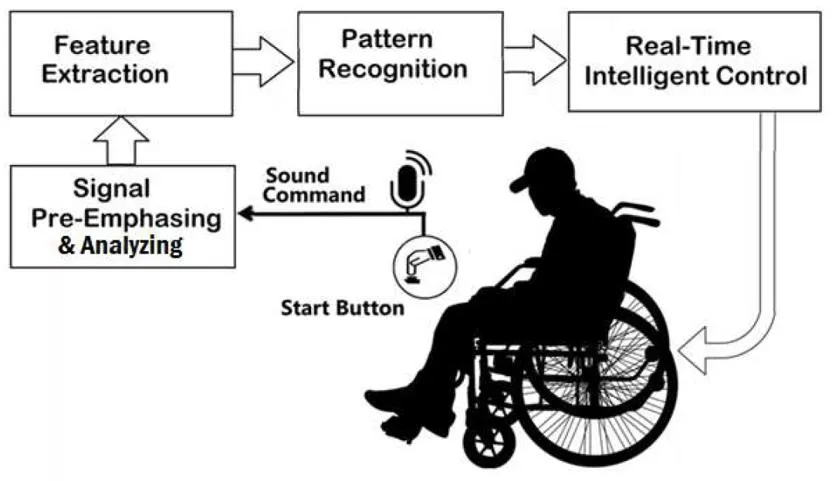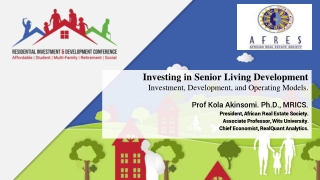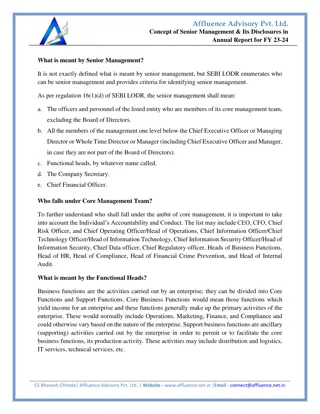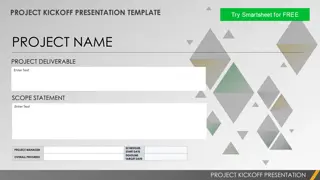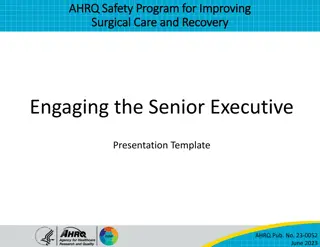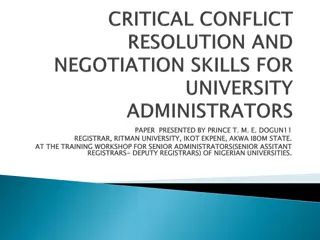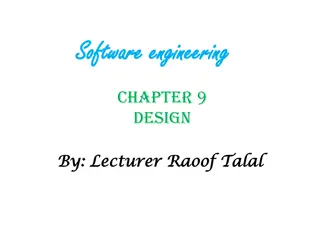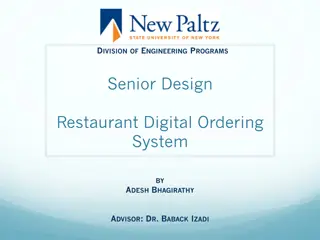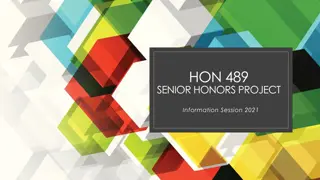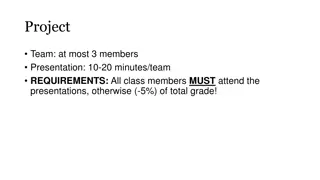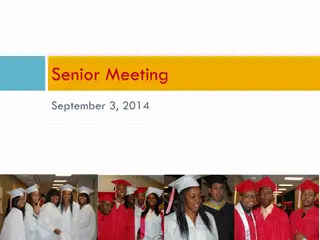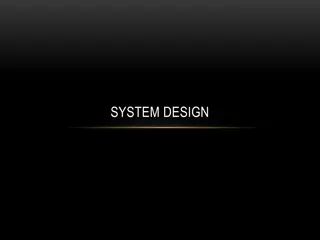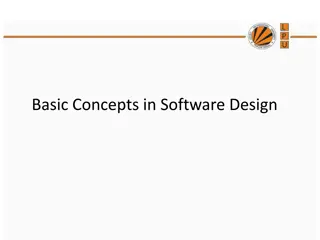Senior Design Project -1 Presentation
Aimed at enabling independent mobility for disabled individuals, this project focuses on controlling a wheelchair through voice commands. Utilizing an ESP32 microcontroller interfaced with motors, the system offers cost-effective solutions with the potential for commercialization to benefit users in developing countries. The project entails mechanical, electrical, and software development phases, including the design of the wheelchair, selection of motion tech actuators, and integration of various electrical components. Key components such as the ESP32 microcontroller play a crucial role in facilitating communication and control functionalities, making the wheelchair operation efficient and user-friendly.
Download Presentation

Please find below an Image/Link to download the presentation.
The content on the website is provided AS IS for your information and personal use only. It may not be sold, licensed, or shared on other websites without obtaining consent from the author. Download presentation by click this link. If you encounter any issues during the download, it is possible that the publisher has removed the file from their server.
E N D
Presentation Transcript
Senior Design Project -1 Presentation DESIGN AND DEVELOPMENT OF VOICE CONTROLLED WHEEL CHAIR PRESENTED BY: RANA AZHAR ABBAS (2020-BEEL-11356) S.KASHAN ALI (2020-BEEL-11420) YASIR QAYYUM (2019-BEEL-10130) PROJECT INTERNAL ADVISOR: SIR DEEPAK DODEJA KARACHI INSTITUTE OF ECONOMICS AND TECHNOLOGY DEPARTMENT OF ELECTRICAL ENGINEERING
AIM AND OBJECTIVES The aim of the project is controlling a wheelchair by means of human voice. It enables a disabled person to move around independently, using a voice recognition application which is interfaced with motors. The prototype of the wheelchair is built using a micro-controller ESP32, chosen for its low cost, in addition to its versatility and performance in mathematical operations and communication with other electronic devices. The system has been designed and implemented in a cost effective way so that if our project is commercialized the needy users in developing countries will benefit from it.
PHASES OF DEVELOPMENT OF VOICE CONTROLLED WHEEL CHAIR Mechanical Electrical Software
MECHANICAL PHASE MECHANICAL PHASE: 1) Wheel Chair Designing
2) 2 Motion Tech Actuators: Specifications Of Motors: Voltage: 24V/DC Power: 200w RPM: 120 Length: 12.5inch Motor Diameter: 82mm Weight Handling Capacity: 50kg Minimum Speed: 6km/h Maximum Speed: 12km/h
ELECTRICAL PHASE ELECTRICAL COMPONENTS: 1) ESP32 2) ON-OFF BUTTON 3) EMERGENCY BUTTON 4) MODE CHANGE BUTTON 5) BUZZER 6) JOYSTICK 7) MOTOR DRIVER 8) LCD 9) BUCK CONVERTER 10) VOICE MODULE 11) 24 VOTLS BATTERY
MICROCONTROLLER ESP32 ESP32 is a standalone or a slave device to host microcontroller that we require in our project. It is designed for mobile, wearable electronics(IoT) applications and can easily help in cloud and server utilization. It has Built in Wifi & Bluetooth Module that will help in the purpose. ESP32 interface with other systems through WiFi and Bluetooth using protocols and serial communication. It has 40 pins that serves for different purpose for I/O, protocols pins supply and ground.
Components Description 1) MODE CHANGE BUTTON: A mode change button for operating a wheel chair at two different modes i) JOYSTICK ii)VOICE CONTROL MODULE ( Urdu and English) 2) Voice recognition module: This voice controlled wheelchair uses unilateral mic. The unilateral mic is capable of ignoring noises apart from the actual voice commands. 3) JOYSTICK: A joystick is known as proportional control. This is the most commonly used type of control. The joystick moves the powered wheelchair in the direction that the user points it in. 4) ESP 32: It can perform as a complete standalone system or as a slave device to a host MCU, reducing communication stack overhead on the main application processor. 5) D.C Motor: The proposed system consists of two DC magnetized, 120 rpm motors (Motion tech motors) to equalize the weight distribution and stall torque. The motors will be attached to all the four wheels and two motor drivers will be connected to each side with 24 volts dc battery. 6) ON-OFF BUTTON: On-off button to initialize the wheel chair.
7) BUZZER: It will beep as soon the wheel chair gets connectivity. 8) BUCK CONVERTER: A buck converter is used to step down voltage of the given input in order to achieve required output. 9) 24 VOLT BATTERY: It will efficient the speed of the wheel chair without any disruptions. 10) Alphanumeric LCD 16*2: A 16x2 LCD means it can display 16 characters per line and there are 2 such lines. In this LCD each character is displayed in 5x7 pixel matrix. 11) Emergency button: Emergency button incase of power failure or emergency it will immediate stops wheel chair.
COMPONENTS CONNECTIONS WITH ESP32 ESP32 Pin no: 14,15,25 and 26 are used as for motor left and right. Pin no: 33 and 32 are used to connect joystick. Vin or ground wires are used as black and red color. Buck converter is used as to step down the voltage 24V to 5V because every IOT part is supported to 5V. LCD is connected to SCL ( Serial communication line) 22 and SDA is connected 21 no. pin. Mode change Button is 3 pin button: i) Middle pin is connected with Center Ground ii) Left Pin is connected with D5 iii) Right Pin is connected with D15 Motor Driver BTS 7690 is used for controlling purpose. PIN no. D4 is connected to Buzzer. LCD is used for data showing purpose, ON-OFF, mode change.
SOFTWARE PHASE: Software used for implementation of code and voice training: THONY IDE Language that we will be using for coding: Micro Python language
PROJECT OVERVIEW TASK TASK remaining TASK In process accomplished Connection of voice module with esp32 Mechanical phase Wheel chair Motor Driver Working on the voice module Electrical Phase All connections with ESP32 Implementation of code to voice module Working on the python code interference on esp32 to connect with voice module kit
DIFFICULTIES FACED DURING PROJECT Components selection. Components purchasing. Faced interconnection issues driver motors to esp32 so it can reduces delay rate. Facing a lot of problems while coding during dual language ( English and Urdu) process. Faced difficulty during the connection of motors with wheel chair.
FINAL DELIVERABLE The final deliverable of our project will be a wheel chair with voice controlling algorithm with dual language ( English and Urdu) including joystick and to provide easy access for physical disabled person who cannot control their movements especially by hands. PROJECT BENEFITS It will reduce human efforts. This will help physically handicapped people who cannot operate things with their hands. This will provide easy movement for physically challenged people.
THANK YOU ! ACKNOWLEDGEMENT We convey our sincere gratitude to Sir Deepak Dodeeja at KARACHI INSTITUTE OF ECONOMICS AND TECHNOLOGY (KIET), for his guidance, support, and motivation to undertake this project. His contribution as a guide to this project is invaluable and commendable.
